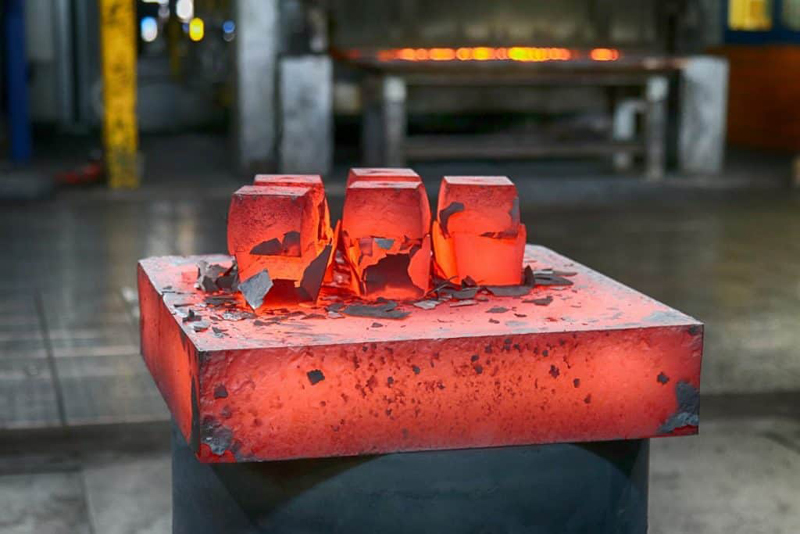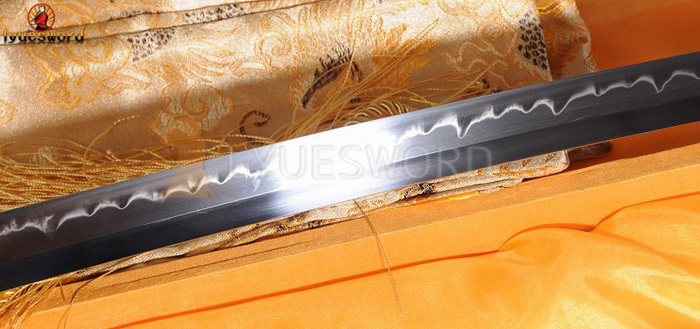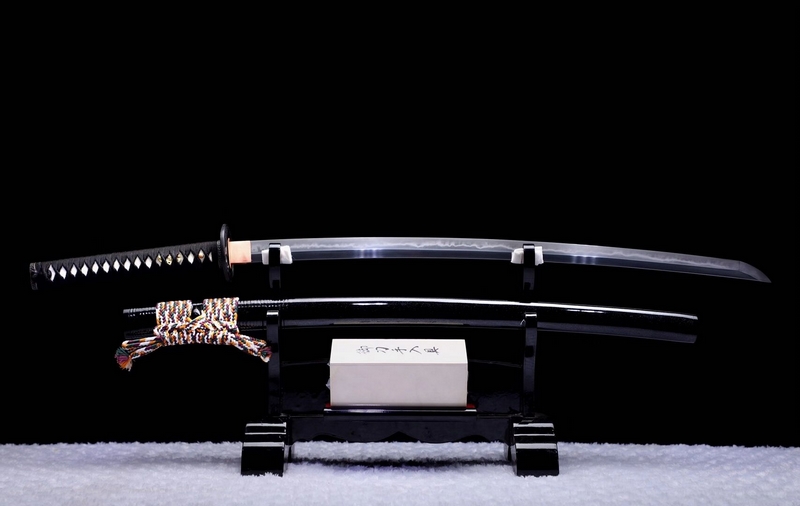By lyuesword | 18 November 2020 | 1 Comments
What is T10 Steel? Is It The Best For Katanas?
What is T10 Steel?
For outsiders, this looks like a bunch of random numbers and letters combined together.
For sword enthusiasts, these names tell us all we need to know about the steel.
What's T10 steel?
The T stands for Tungsten. One of the unique properties of this steel.
The 10 stands for the amount of carbon in the steel. In this case, that will be somewhere around 1.0%, hence the 10.
The T10 is a high-speed tool steel. It’s known for its strength and ability to withstand extreme temperatures in manufacturing.
On the Rockwell hardness scale, T10 can reach up to 67 HRC – which is hella hard.
But that’s not why you want to learn about T10… is it?
No, the reason you’re here is that you want to know why T10 is so popular for katanas.
Because of the properties of this steel.
T10 Steel Properties

What differentiates types of steel from one another are the substances that go into them. These may be small amounts, but they have a big impact on the overall product.
T10 has a combination of 5 ingredients:
• Carbon 0.95 – 1.04%
• Silicon ≤ 0.35%
• Manganese ≤ 0.4%
• Phosphorous ≤ 0.035%
• Sulfur ≤ 0.03%
At first glance, those all look pretty normal. It’s awfully close in composition to 1095 steel.
If you add the percentages above, you’ll get somewhere around 1.8%. What makes the remaining 98.2% of the steel?
Tungsten.
T10 is tungsten-based steel.
Most steels are iron-based. Iron is what takes up the remaining 90+% of them, but not the T10.
Instead of an iron-base, the T10 uses tungsten alloy.
How does this affect the steel? And how do the other ingredients in the steel change the way it reacts?
Tungsten
This is easily the most unique thing about T10. Tungsten is what makes T10 high-speed steel.
What’s high-speed steel? High-speed steel is a type of tool steel that is used for cutting. It’s strength and heat-resistant makes it very effective at this. That’s why you’ll see T10 in power saws and drill bits.
For katanas, the tungsten base gives it extra strength and durability. On the battlefield, these are crucial factors for your sword.
Carbon
T10 is a high-carbon steel. 0.95 – 1.04% might not sound like a lot, but in the world of steel, it is.
High-carbon steels come with their own set of advantages and disadvantages.
For one, the high content makes the T10 incredibly hard, sharp, and durable. This is why it works perfectly for swords such as katanas. On the flip side, this isn’t stainless steel.
If you don’t take good care of your T10 steel, it will rust. So be careful!
Also, it is a challenge to sharpen these blades. Because it’s so hard, your ordinary sharpening sone won’t do.
You’ll need something hard to put an edge on a T10.
Other Materials
The silicon, manganese, phosphorous, and sulfur are all in tiny amounts. Yet they do have an effect.
These materials add a little extra strength to the blade. Some of them also make the steel easier to cut and fold.

Why is T10 Steel good for making Katana?
Now that you know what goes into T10 steel, you’ll be wondering why I say its so good for katanas. There are several reasons.
Because of its high-carbon content, T10 can become ridiculously sharp.
Those legends you hear about katanas? Steel like T10 can make them a reality.
Ever heard that katanas can cut machine gun barrels? Or that katanas can cut a person in half? It’s unlikely they can actually do this. But with T10 steel, you could have a go.
But that’s not all. The tungsten-based T10 is also crazy durable.
It’s so hard, it won’t bend or chip even when you chop through hard materials. Check out this video to get an idea of how strong this steel is:
If you were on a battlefield, that’s the kind of strength and durability you would need. Remember, you’ll have to cut through armor and human bones. Imagine how much damage that would do to a weak katana.
How to Choose a T10 Katana
If you were to get a katana, T10 steel is easily one of your better options. That said, steel isn’t everything.
Yes, you need good steel. But you also have to be careful about the way the sword was forged.
Today, there are too many cheap manufacturers who advertise their products as “authentic katanas”. When in reality, no effort or quality was put behind these swords. They’re mass-produced, cheap, and low-quality.
So how do you spot a good one from a bad one?
Hamon
If you’re familiar with blade steel, you’ll know this: The harder the steel, the more brittle it becomes.
If that’s the case, how then do katanas get so hard and sharp, yet stay strong and durable?
If you answered “T10!” you’d be right.
But that’s not all. A lot of the strength of the katana comes from the way it is built.
Instead of using one block of steel for the entire blade, swordsmiths give katanas hard areas and soft areas.
The hard areas are at the edge of the blade. These need to be as strong and sharp as possible.
The soft areas, one the other hand, are at the spine of the blade. These softer areas make the katana flexible. This way, when there’s a big impact, the blade won’t shatter.
Now, how can you tell if a katana is made this way? Its hamon.
Did you ever see that squiggly uneven line that runs through the body of katana blades? That’s the hamon. It’s the area that splits the hard and soft parts of the blade.
Real hamons can sometimes be hard to see, but they’re there. They’re the ones that tell you your katana is not just one solid block of steel. They also look amazing.
One of the appeals of katanas is how beautiful they are. With a good hamon, they become even more irresistible.
Folds
Another sign your katana is legit are the fold lines on the blade.
Authentic katanas are made in a special way. Japanese blacksmiths had to fold steel over and over again to remove all impurities.
By the time they finished, they had pure steel – steel that didn’t have those little flecks of other material that could ruin its performance.
Now, how can you tell if a blade has been folded over and over again? Fold lines.
Whenever you get a katana, inspect the blade for these.
If you don’t see any lines (keep in mind that these lines are quite small), you know the blade hasn’t been folded.
On the contrary, if you see lines running along the blade, you know how this was folded. The more lines, the more times it was folded.
However, a blade that wasn’t folded isn’t necessarily a bad thing. It can simply mean that the steel was pure from the start – hence, no need to fold it anymore.
But there’s something about those fold lines that are so attractive. They’re one of the things that make katanas look and feel more authentic.
Others
Looking at the blade is so important. However, there are several other things you should consider before buying a katana.

I go in-depth on this topic in another of my articles. Check it out here: How to Choose the Best Katana.
For outsiders, this looks like a bunch of random numbers and letters combined together.
For sword enthusiasts, these names tell us all we need to know about the steel.
What's T10 steel?
The T stands for Tungsten. One of the unique properties of this steel.
The 10 stands for the amount of carbon in the steel. In this case, that will be somewhere around 1.0%, hence the 10.
The T10 is a high-speed tool steel. It’s known for its strength and ability to withstand extreme temperatures in manufacturing.
On the Rockwell hardness scale, T10 can reach up to 67 HRC – which is hella hard.
But that’s not why you want to learn about T10… is it?
No, the reason you’re here is that you want to know why T10 is so popular for katanas.
Because of the properties of this steel.
T10 Steel Properties

What differentiates types of steel from one another are the substances that go into them. These may be small amounts, but they have a big impact on the overall product.
T10 has a combination of 5 ingredients:
• Carbon 0.95 – 1.04%
• Silicon ≤ 0.35%
• Manganese ≤ 0.4%
• Phosphorous ≤ 0.035%
• Sulfur ≤ 0.03%
At first glance, those all look pretty normal. It’s awfully close in composition to 1095 steel.
If you add the percentages above, you’ll get somewhere around 1.8%. What makes the remaining 98.2% of the steel?
Tungsten.
T10 is tungsten-based steel.
Most steels are iron-based. Iron is what takes up the remaining 90+% of them, but not the T10.
Instead of an iron-base, the T10 uses tungsten alloy.
How does this affect the steel? And how do the other ingredients in the steel change the way it reacts?
Tungsten
This is easily the most unique thing about T10. Tungsten is what makes T10 high-speed steel.
What’s high-speed steel? High-speed steel is a type of tool steel that is used for cutting. It’s strength and heat-resistant makes it very effective at this. That’s why you’ll see T10 in power saws and drill bits.
For katanas, the tungsten base gives it extra strength and durability. On the battlefield, these are crucial factors for your sword.
Carbon
T10 is a high-carbon steel. 0.95 – 1.04% might not sound like a lot, but in the world of steel, it is.
High-carbon steels come with their own set of advantages and disadvantages.
For one, the high content makes the T10 incredibly hard, sharp, and durable. This is why it works perfectly for swords such as katanas. On the flip side, this isn’t stainless steel.
If you don’t take good care of your T10 steel, it will rust. So be careful!
Also, it is a challenge to sharpen these blades. Because it’s so hard, your ordinary sharpening sone won’t do.
You’ll need something hard to put an edge on a T10.
Other Materials
The silicon, manganese, phosphorous, and sulfur are all in tiny amounts. Yet they do have an effect.
These materials add a little extra strength to the blade. Some of them also make the steel easier to cut and fold.

Why is T10 Steel good for making Katana?
Now that you know what goes into T10 steel, you’ll be wondering why I say its so good for katanas. There are several reasons.
Because of its high-carbon content, T10 can become ridiculously sharp.
Those legends you hear about katanas? Steel like T10 can make them a reality.
Ever heard that katanas can cut machine gun barrels? Or that katanas can cut a person in half? It’s unlikely they can actually do this. But with T10 steel, you could have a go.
But that’s not all. The tungsten-based T10 is also crazy durable.
It’s so hard, it won’t bend or chip even when you chop through hard materials. Check out this video to get an idea of how strong this steel is:
If you were on a battlefield, that’s the kind of strength and durability you would need. Remember, you’ll have to cut through armor and human bones. Imagine how much damage that would do to a weak katana.
How to Choose a T10 Katana
If you were to get a katana, T10 steel is easily one of your better options. That said, steel isn’t everything.
Yes, you need good steel. But you also have to be careful about the way the sword was forged.
Today, there are too many cheap manufacturers who advertise their products as “authentic katanas”. When in reality, no effort or quality was put behind these swords. They’re mass-produced, cheap, and low-quality.
So how do you spot a good one from a bad one?
Hamon
If you’re familiar with blade steel, you’ll know this: The harder the steel, the more brittle it becomes.
If that’s the case, how then do katanas get so hard and sharp, yet stay strong and durable?
If you answered “T10!” you’d be right.
But that’s not all. A lot of the strength of the katana comes from the way it is built.
Instead of using one block of steel for the entire blade, swordsmiths give katanas hard areas and soft areas.
The hard areas are at the edge of the blade. These need to be as strong and sharp as possible.
The soft areas, one the other hand, are at the spine of the blade. These softer areas make the katana flexible. This way, when there’s a big impact, the blade won’t shatter.
Now, how can you tell if a katana is made this way? Its hamon.
Did you ever see that squiggly uneven line that runs through the body of katana blades? That’s the hamon. It’s the area that splits the hard and soft parts of the blade.
Real hamons can sometimes be hard to see, but they’re there. They’re the ones that tell you your katana is not just one solid block of steel. They also look amazing.
One of the appeals of katanas is how beautiful they are. With a good hamon, they become even more irresistible.
Folds
Another sign your katana is legit are the fold lines on the blade.
Authentic katanas are made in a special way. Japanese blacksmiths had to fold steel over and over again to remove all impurities.
By the time they finished, they had pure steel – steel that didn’t have those little flecks of other material that could ruin its performance.
Now, how can you tell if a blade has been folded over and over again? Fold lines.
Whenever you get a katana, inspect the blade for these.
If you don’t see any lines (keep in mind that these lines are quite small), you know the blade hasn’t been folded.
On the contrary, if you see lines running along the blade, you know how this was folded. The more lines, the more times it was folded.
However, a blade that wasn’t folded isn’t necessarily a bad thing. It can simply mean that the steel was pure from the start – hence, no need to fold it anymore.
But there’s something about those fold lines that are so attractive. They’re one of the things that make katanas look and feel more authentic.
Others
Looking at the blade is so important. However, there are several other things you should consider before buying a katana.

I go in-depth on this topic in another of my articles. Check it out here: How to Choose the Best Katana.
Recently Reviews
Read MoreLeave a Reply
Your email address will not be published.Required fields are marked. *